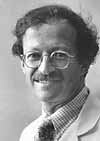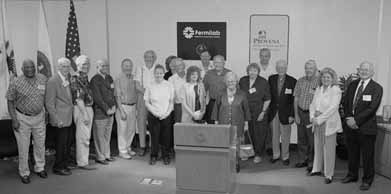 |
|
Interdependent Sciences: Physics and Medicine by Michael S. Witherell
Many diagnostic and therapeutic techniques that have revolutionized medicine are also symbols of the interdependence of the physical and biomedical sciences. Magnetic Resonance Imaging and Neutron Therapy are just two of the prominent examples of the successful collaboration among innovative medical researchers, physical scientists and engineers. Electron storage rings first developed for high energy physics evolved into synchrotron light sources; they are now so important to medical research that the National Institutes of Health is putting millions of its own research money into building more beam lines at synchrotron facilities.
"I first observed the interdependence of the sciences as a boy when my father-a general practitioner with an office connected to our house-showed me an X-ray. I marveled at a technology that could reveal the bones of his patients or the guts of our pets. And I learned that it was something that doctors, no matter how expert with a stethoscope or suture, wouldn't have been likely to develop on their own.
"Of course, the X-ray is routine now. Medical science can visualize the inner workings of the body at far higher resolution with techniques that sound dazzlingly sophisticated: ultrasound, positron-emission tomography and computer-assisted tomography. These techniques are the workhorses of medical diagnostics. And not a single one of them could have been developed without the contributions of scientists, such as mathematicians, physicists and chemists supported by the agencies currently at risk.
"Medical advances may seem like wizardry. But pull back the curtain, and sitting at the lever is a high-energy physicist, a combinational chemist or an engineer. Magnetic resonance imaging is an excellent example. Perhaps the last century's greatest advance in diagnosis, MRI is the product of atomic, nuclear and high-energy physics, quantum chemistry, computer science, cryogenics, solid-state physics and applied medicine.
"In other words, the various sciences together constitute the vanguard of medical research. And it's time for Congress to treat them that way. Sens. Christopher Bond (R-Mo.) and Barbara Mikulski (D-Md.) have just proposed to double the budget of the National Science Foundation over five years. This admirable effort should be vigorously supported and extended to include the Department of Energy's Office of Science, which funds half of all research in the physical sciences and maintains the national laboratories that are central to biomedicine.
"Scientists can wage an effective war on disease only if we-as a nation and as a scientific community-harness the energies of many disciplines, not just biology and medicine. The allies must include mathematicians, physicists, engineers and computer and behavioral scientists. I made this case repeatedly during my tenure as director of NIH, and the NIH has made significant efforts to boost its support of these areas. But in the long run, it is essential to provide adequate budgets for the agencies that traditionally fund such work and train its practitioners. Moreover, this will encourage the interagency collaboration that fuels interdisciplinary science. Only in this way will medical research be optimally poised to continue its dazzling progress."
I cannot improve on such an eloquent statement. I will simply add that in most of these important medical developments, the new technology was a result of research that was not directed at developing medical technology. The scientists did not envision this most beneficial use of the research they were carrying out. The physicists who first built a laser could not have imagined the many ways that it is used in medicine today. Science is not a collection of many disciplines, advancing independently. It is rather an interlocking web. If we ignore the deep connections between the many individual fields of science, we miss the importance of the whole. On the Web: Pulse--Accelerator Science in Medicine http://www.fnal.gov/pub/pulse |
| last modified 9/15/2001 by C. Hebert email Fermilab |
FRLsDFx9eyfrPXgV
 Harold Varmus, the president of Memorial Sloan-Kettering Cancer Center, former director of the National Institutes of Health and recipient of the 1989 Nobel Prize in Medicine, wrote an Op-Ed article for the Washington Post about a year ago discussing this interdependence of the physical and medical sciences. He noted that support for the physical sciences has been falling for a decade, at the same time that support for medical research almost doubled in real dollars. Dr. Varmus wrote:
Harold Varmus, the president of Memorial Sloan-Kettering Cancer Center, former director of the National Institutes of Health and recipient of the 1989 Nobel Prize in Medicine, wrote an Op-Ed article for the Washington Post about a year ago discussing this interdependence of the physical and medical sciences. He noted that support for the physical sciences has been falling for a decade, at the same time that support for medical research almost doubled in real dollars. Dr. Varmus wrote:
 "Effective medicines are among the most prominent products of medical research, and drug development also relies heavily on contributions from a variety of sciences. The traditional method of random prospecting for a few promising chemicals has been supplemented and even superseded by more rational methods based on molecular structures, computer-based images and chemical theory. Synthesis of promising compounds is guided by new chemical methods that can generate either pure preparations of a single molecule or collections of literally millions of subtle variants. To exploit these new possibilities fully, we need strength in many disciplines, not just pharmacology.
"Effective medicines are among the most prominent products of medical research, and drug development also relies heavily on contributions from a variety of sciences. The traditional method of random prospecting for a few promising chemicals has been supplemented and even superseded by more rational methods based on molecular structures, computer-based images and chemical theory. Synthesis of promising compounds is guided by new chemical methods that can generate either pure preparations of a single molecule or collections of literally millions of subtle variants. To exploit these new possibilities fully, we need strength in many disciplines, not just pharmacology.